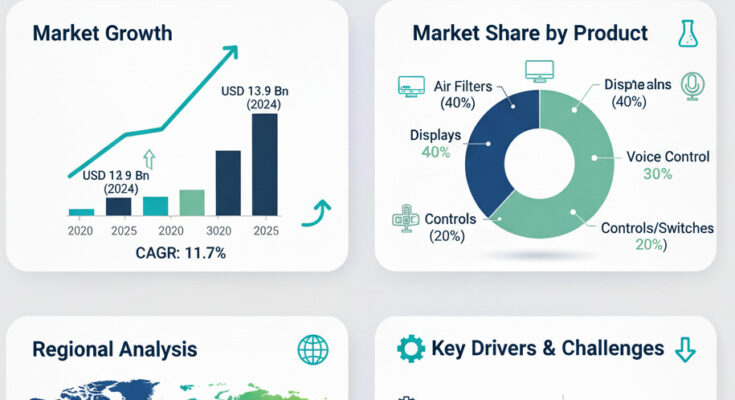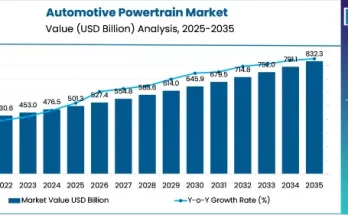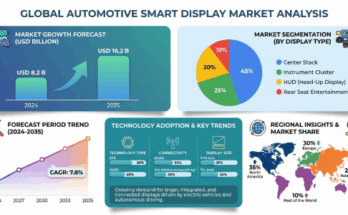The global Automotive Human Machine Interface (HMI) market is poised for robust growth, expanding from US$ 13.9 billion in 2024 to US$ 39.5 billion by 2034, registering a CAGR of 11.0%, according to Fact.MR, a leading market research and competitive intelligence provider. The market is witnessing unprecedented growth as automakers integrate advanced digital interfaces, voice recognition, gesture controls, and haptic feedback systems to deliver intuitive and personalized vehicle experiences.
Market Overview
-
Market Size (2023A): US$ 12.5 billion
-
Estimated Value (2024E): US$ 13.9 billion
-
Forecast Value (2034F): US$ 39.5 billion
-
Forecast CAGR (2024–2034): 11.0%
-
North America Market Share (2024E): 35.8%
-
East Asia Market Growth Rate (2024–2034): 11.4%
-
U.S. CAGR (2024–2034): 11.3%
The automotive HMI market is a critical junction of human interaction and vehicle technology, enabling drivers and passengers to engage with infotainment, navigation, diagnostics, and safety systems seamlessly. The transition from basic button controls to multimodal interfaces has transformed cockpit design, with visual interfaces holding a 40.2% market share in 2024, valued at US$ 5.6 billion.
Market Drivers
-
Advanced Technology Integration: Touchscreens, voice recognition, gesture controls, and haptic feedback have created intuitive, user-friendly vehicle experiences. Integration with smartphones, digital assistants, and over-the-air updates has become standard, reflecting growing consumer expectations for seamless digital experiences.
-
Electrification and Autonomous Driving: EVs and autonomous vehicles require interfaces to monitor battery status, ADAS features, and autonomous modes, pushing HMI innovation forward.
-
Passenger Comfort and Personalization: Growing consumer demand for customized interfaces in passenger vehicles fuels development in multimodal interaction, augmented reality dashboards, and biometric authentication.
-
Connectivity Trends: Increasing use of connected car technologies and smart cockpits encourages manufacturers to implement unified, adaptive HMI solutions.
Historical and Forecast Market Trends
-
2019–2023: Market grew at a CAGR of 10.7%, reaching US$ 12.5 billion in 2023, driven by post-pandemic recovery and accelerated digitization of vehicles.
-
Short Term (2024–2027): Focus on AI-driven voice recognition, responsive interfaces, and strategic partnerships between OEMs and tech companies.
-
Medium Term (2027–2030): Adoption of augmented reality (AR) and holographic displays, standardized platforms, and eco-friendly interface designs.
-
Long Term (2030–2034): Advanced autonomous vehicle cockpits, adaptive AI interfaces, and immersive multi-sensory experiences.
Segment Insights
By Vehicle Type:
-
Passenger Vehicles: Largest segment, creating an absolute $ opportunity of US$ 19.3 billion between 2024–2034. Premium vehicles drive early adoption of advanced HMI solutions.
-
Commercial Vehicles, Sedans, Hatchbacks, SUVs: Increasing implementation of HMI for operational efficiency, safety, and passenger comfort.
By Technology:
-
Visual Interfaces: 40.2% share in 2024; essential for navigation and infotainment.
-
Mechanical, Acoustic, Haptic Interfaces: Integrated with multimodal systems for enhanced interactivity.
By Product Type:
-
Voice Controls, Central Displays, Instrument Clusters, Steering-Mounted Controls, HUDs, Rear-Seat Entertainment (RSE) Displays: Comprehensive solutions offering both functional and entertainment capabilities.
Regional Insights
-
United States: Market value US$ 3.3 billion in 2024; CAGR 11.3%. High adoption of voice control systems and smartphone integration. Strong ecosystem of tech and automotive companies drives innovation. Absolute dollar opportunity: US$ 6.3 billion (2024–2034).
-
China: Market expected to reach US$ 5.8 billion by 2034; CAGR 11.5%. Rapid adoption of connected car technologies, smart cockpits, and EVs drives growth. Government policies promoting vehicle electrification further enhance HMI adoption.
-
Japan & South Korea: CAGR 11.6% and 10.7% respectively, driven by automotive technology leadership and consumer preference for premium digital features.
-
Other Regions: Europe, Latin America, South Asia, and Middle East & Africa see steady adoption, emphasizing regulatory compliance and premium feature integration.
Market Challenges
-
Technical Complexity: Integrating multiple interfaces, maintaining compatibility, and reducing driver distraction is challenging.
-
Safety and Compliance: Extensive testing and validation increase costs and development cycles.
-
Balancing Cost vs. User-Friendliness: Advanced HMI solutions require significant R&D investment, affecting affordability for mid-segment vehicles.
Competitive Landscape
Key market participants include: DENSO Corporation, Valeo SA, Continental AG, Harman International, Delphi Automotive plc, Magneti Marelli S.P.A, Visteon Corporation, Clarion Co. Ltd., Tata Elxsi, Luxoft, Elektrobit, Auto-Electronics, Nuance Communications Inc, EAO AG.
Recent Innovations:
-
Continental AG (Mar 2024): New automotive displays with 3D and eye-tracking technology.
-
DENSO Corporation (Nov 2023): AI-powered HMI system with driver monitoring and adaptive personalization.
-
Visteon Corporation (Jun 2023): SmartCore cockpit domain controller supporting multiple displays and seamless integration.
Browse Full Report : https://www.factmr.com/report/40/automotive-human-machine-interface-market
Outlook
The automotive HMI market will continue to grow at a strong pace, driven by passenger vehicle digitization, EV adoption, and premium feature demand. Manufacturers investing in adaptive AI, immersive interfaces, and connectivity solutions are poised to capture the largest market share by 2034.



